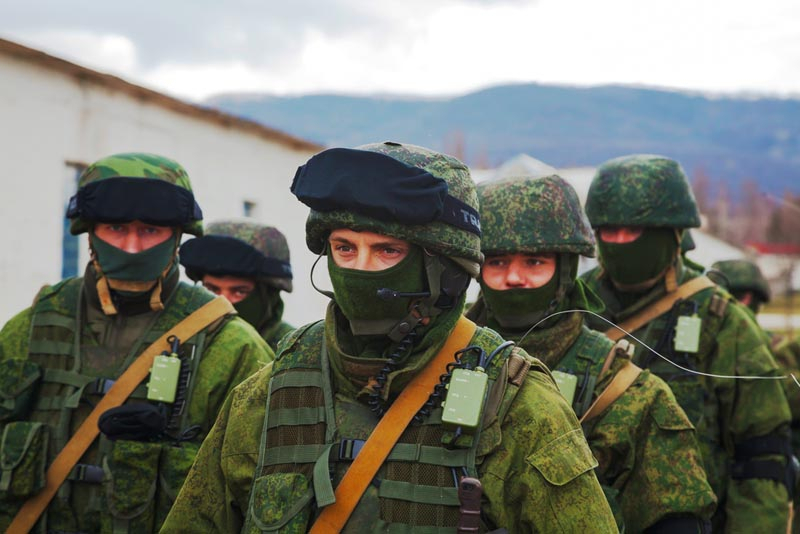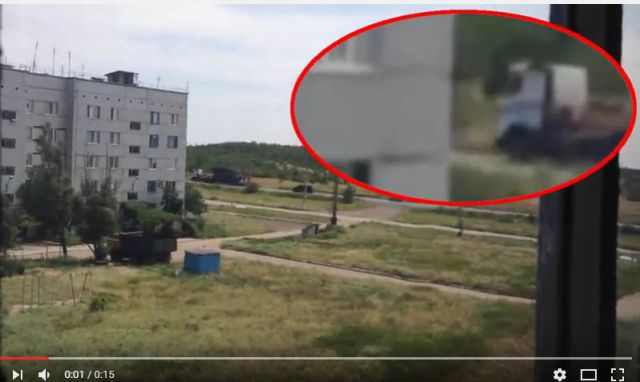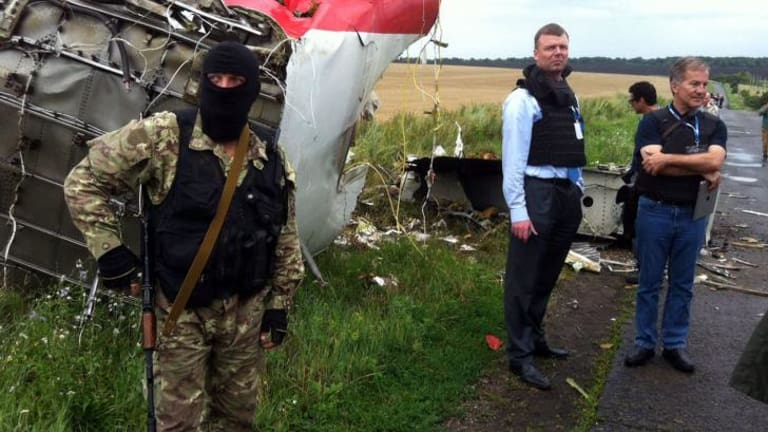Not only the Russians, but also scores of western politicians and commentators use the term 'civil war' for the armed conflict in the Donbas. This is a false flag, argues researcher Tobias Wals, to deny Russia's heavy involvement in the military operation. It is meant to drag on the conflict, hinder Ukraine's integration into Europe and let Russia get away with it. Don't use that incorrect term.
 It all started with the 'little green men' without insignia in Crimea. They were Russian commando's (picture shutterstock)
It all started with the 'little green men' without insignia in Crimea. They were Russian commando's (picture shutterstock)
by Tobias Wals
This spring marks the fifth anniversary of the war in the Donbas, the densely populated mining region in the far east of Ukraine. It’s a rather grim jubilee: the conflict so far took an estimated 13.000 lives, 3.300 of which civilian — in postwar Europe comparable only to the Balkan wars of the nineties. According to the Ukrainian government, at least 1.5 million people are displaced. This number does not include the hundreds of thousands that have sought refuge elsewhere, mainly in Russia.
Sometimes called a 'forgotten war', because of low media coverage, the Donbas conflict has recently drawn renewed attention. Volodymyr Zelensky’s landslide victory at the Ukrainian presidential elections in April raised hopes of a breakthrough in the deadlocked peace process. Hopes that were crushed by Moscow’s decision, only days later, to hand out Russian passports to inhabitants of Ukraine’s so-called 'temporarily occupied territories' — widely interpreted as a provocative gesture towards the Ukrainian president-elect.
Meanwhile, many people in the West — both politicians and journalists — still refer to the conflict in Eastern Ukraine as a civil war. A grievous misconception. 'Civil war' may sound neutral, but in the context of the Donbas it’s a deceptive term that conceals the true nature of the conflict: a Russian act of aggression against the Ukrainian state. What is worse, the framing of the conflict as a civil war — i.e. an internal Ukrainian affair — indirectly serves Russian interests. So let's set straight why this is a false flag.
Non-international armed conflict
First of all the term 'civil war' has no legal significance — which in itself is a reason to not use it without caution. It more of less corresponds to what specialists of international law call a 'non-international armed conflict'. The tricky thing is that almost all non-international armed conflicts have an international component (e.g. Syria); just like nearly all international conflicts have a non-international or internal component (e.g. Afghanistan). The distinction is slippery, and in the case of the Donbas, it is going to take many years before a body of international justice will decide on a formal classification.
 The Russian Buk missile system coming from the Russian town of Kursk here traced in Ukrainian Zjores
The Russian Buk missile system coming from the Russian town of Kursk here traced in Ukrainian Zjores
In the meantime, we can rely on a vast body of evidence that unambiguously points in the direction of Russian interference in Eastern Ukraine. From the earliest stages of the conflict, right after the deposing of president Viktor Yanukovych, Russian troops were present in the Donbas, reinforcing the ranks of the local separatist militias. Many of these men — who were fighting without insignias to conceal their identity — have been identified via their social media accounts by the research journalists of Bellingcat and others.
The weapons used by the militias also, for the greater part, came from Russia — the most notorious example being the BUK missile system that was used to shoot down the MH17 passenger aircraft. The international Joint Investigation Team has since traced it back to the 53rd brigade of the Russian armed forces from Kursk.
One particular case is that of the (former) Russian security officer Igor Girkin (alias Strelkov), who also took part in the annexation of Crimea. In mid-April, 2014, Girkin led a group of Russian speznaz forces deeply into Ukrainian territory and occupied the city of Slovyansk. They held the city until they were pushed back by the advancing Ukrainian army, some three months later. One of Girkin’s subordinates has described this campaign in detail in his recently published memoirs.
In the first months of 2014, the fighting in the Donbas still took place under the guise of an internal Ukrainian affair, at least superficially, but by the end of the summer, the picture had changed dramatically. Faced by the advance of the Ukrainian forces, who by early August were close to cutting off the occupied areas from the Russian border, Moscow launched a large-scale tank offensive, supported by artillery bombardments from Russian territory. Within a few weeks’ time, the Ukrainian military was pushed back dozens of kilometers. In the decisive battle of Ilovaysk, in August, hundreds of Ukrainian soldiers died.
The most clear answer to the question of whether Russia is involved in the Donbas conflict are two maps of the frontline, from mid-August and mid-September, showing an inexplicable expansion of the occupied areas, especially along the strategically important Black Sea coast. Eventually, this offensive forced Kyiv to sign the Minsk Agreements, a stillborn ceasefire that was doomed from the start, because Russia refused to join the table as a warring party.
Non-frozen conflict
Five years later, Ukraine still struggles with the not-so-frozen conflict in the Donbas. The self-proclaimed 'people’s republics' of Donetsk and Luhansk are under full control of the Russian security forces. Many of the local separatists of the first hour, who turned out to be too difficult to control, have been eliminated and replaced with Kremlin-loyal puppets — sometimes imported from Russia. This is also what most likely happened to the commander of the Donbas militias, Aleksandr Zakharchenko, who died in a bomb explosion, last year.  OSCE's monitor Alexander Hug on the site of the MH17 crash. OSCE's mandate is very limited (picture OSCE)
OSCE's monitor Alexander Hug on the site of the MH17 crash. OSCE's mandate is very limited (picture OSCE)
Russia still denies being a party to the conflict and maintains that the Russian citizens fighting in the Donbas do so on their own initiative. Moscow regularly points out the fact that the Organisation for Security and Peace in Europe, which oversees the implementation of the Minks Agreements, does not breathe a word about Russian involvement (a fact that has caused frustration in Ukraine). However, the OSCE’s mission has a limited mandate, which does not allow its observers to check the background of military material and personal. In other words, when they see a tank without markings, they have no means to determine where it came from or to identify the driver. It should be noted that OSCE drones do regularly spot state-of-the-art Russian weapon systems in the occupied areas.
Another source of ambiguity is the Ukrainian government itself. Ukraine’s leaders publicly speak of a war with Russia and the 2018 law on the de-occupation of the Donbas formally introduced the qualification 'armed aggression by the Russian Federation'. However, Ukraine has never formally declared war on Russia — not after the annexation of Crimea, nor after the outbreak of the Donbas conflict. This is not surprising: in 2014, declaring war would have provoked further escalation, something both Kyiv and its Western partners wanted to avoid at all costs.
Somewhat trickier is Ukraine’s signing of the Minsk Agreements. As said, Russia did not join the negotiations as a party to the conflict, leaving that role to the puppet-leadership of the self-proclaimed Donetsk and Luhansk People’s Republics. Therefore, the agreements could be (and often are) interpreted as a form of recognition from the side of Ukraine that the conflict is non-international. However, apart from the fact that 'Minsk' was basically forced upon Ukraine, the agreements have in fact little legal significance — meaning that any future ruling of an international court is likely to ignore the implications of the Minsk Agreements and instead be based on the outcomes of an investigation. The same goes for the absence of a declaration of war or, for that matter, the findings of the OSCE observation mission.
Two lawsuits
To date, Ukraine has filed two lawsuits against the Russian Federation concerning the Donbas conflict (plus two more exclusively concerning Crimea and the Kerch strait): one at the International Court of Justice and one at the International Criminal Court. In the latter case, the ICC prosecutor considers that there is a parallel existence of a non-international and an international conflict in the Donbas. As the start of the international conflict, it has designated July 17, 2014 — the day of the MH17 catastrophe. The Prosecutor is currently finalizing its preliminary examination of the conflict and will soon announce whether it is opening an investigation into Russia’s involvement.
It is a peculiarity of international law that a conflict can exist in an international and a non-international dimension at the same time. The layman’s term 'civil war', however, does not allow for such nuances. To use it in the case of the Donbas is to ignore the countless indicators of large-scale Russian involvement in the conflict, which, although not conclusively proved, are hard to trivialize. It is therefore imperative to use other, more neutral qualifications to describe what is going on in Eastern Ukraine.
There is another issue with the term 'civil war'. Moscow’s persistent denial of involvement is part of a larger strategy: as long as the Russians do not join the Minsk consultations as a party to the conflict, all peace negotiations are pointless. In this way, they can stretch the conflict infinitely, thus ensuring that Ukraine won’t find its way out of economic misery — let alone towards European or Atlantic cooperation. Moreover, by spreading the impression that Ukraine is involved in a civil war, Russia manipulates public opinion in the West: if European and American politicians believe that the Donbas conflict is an internal Ukrainian affair, support for prolongation of the anti-Russian sanctions might diminish. It is no coincidence that 'Ukraine' and 'civil war' are a fixed combination in the Russian media (including RT).
Instrument in info-war
Thus, 'civil war' is not just an inadequate term to describe the situation in the Donbas — it is in fact an instrument in Russia’s information war against Ukraine. It’s not just incorrect — it is misleading. And in a time when pressure is rising to cancel or scale down sanctions against Russia (see for instance the decision, last Friday , to return Russia its suspended voting rights in the Council of Europe), this mantra bears repeating.
Finally, in case you are in doubt what qualifications are okay to use: specialists of international law commonly use the crisis in and around Ukraine, so as to emphasize the international dimension. But if that is too much of a mouthful, the conflict in Eastern Ukraine is a safe bet and so is the war in the Donbas, or any variation on one of these two. And, especially in a broader context, the Russian-Ukrainian conflict is also fine.
